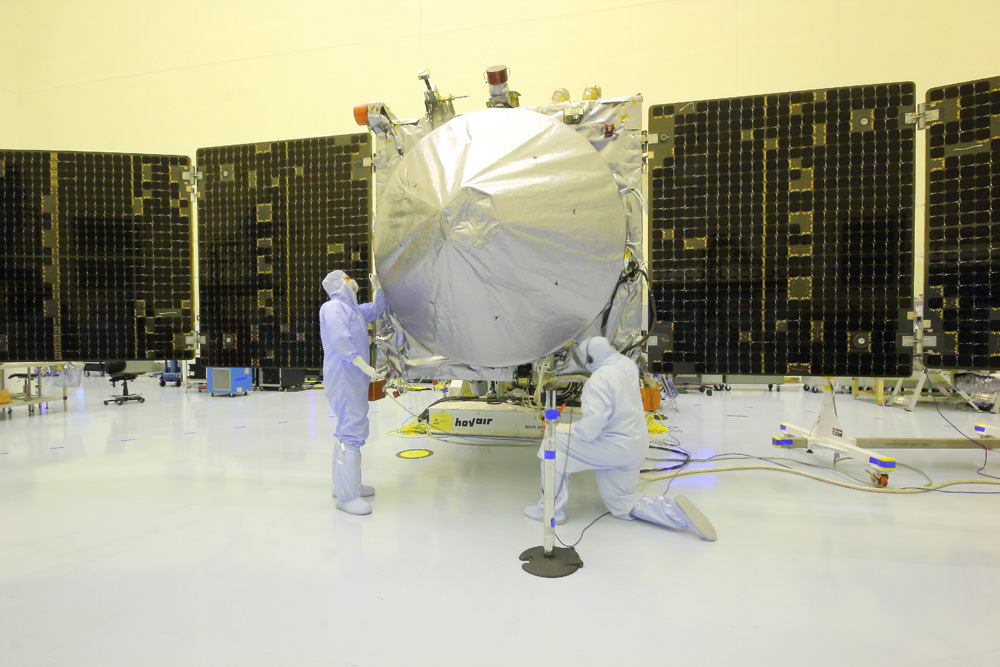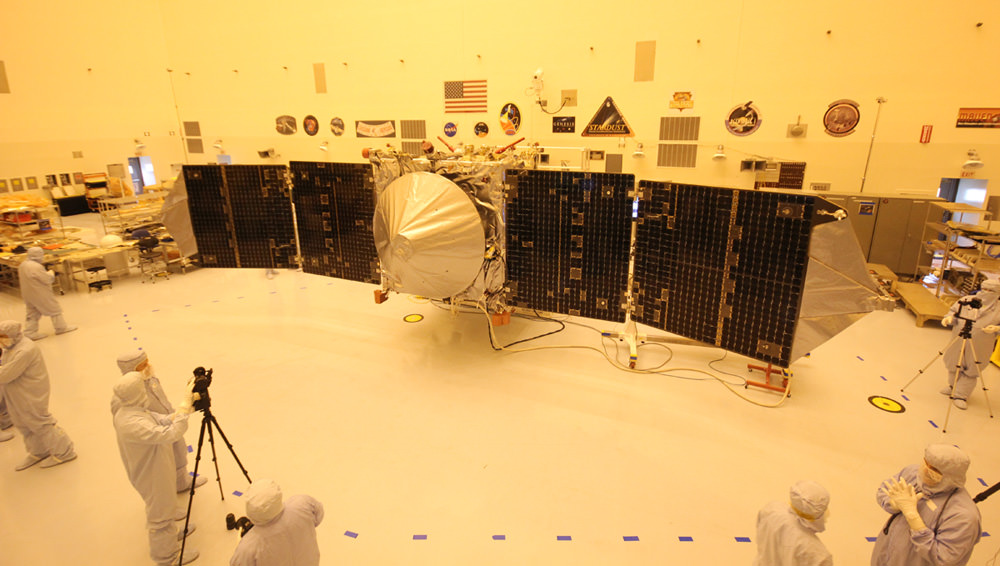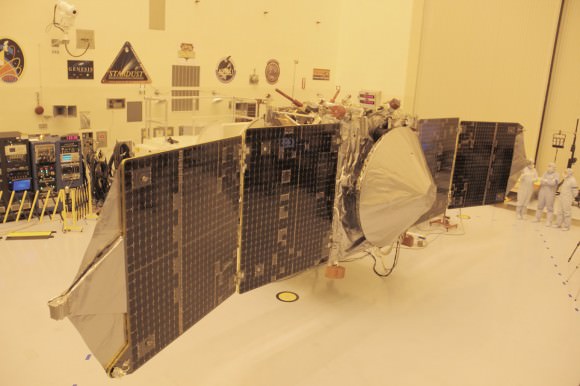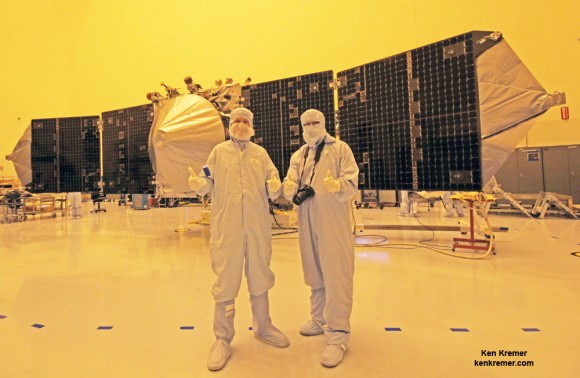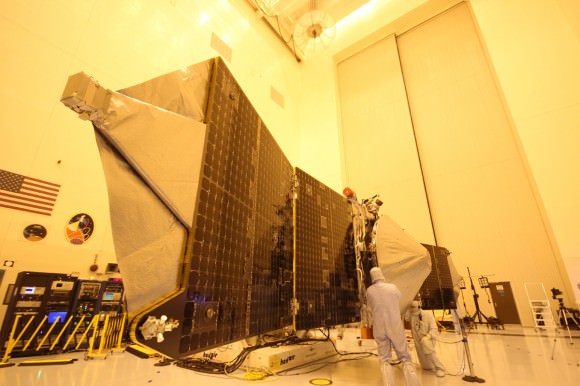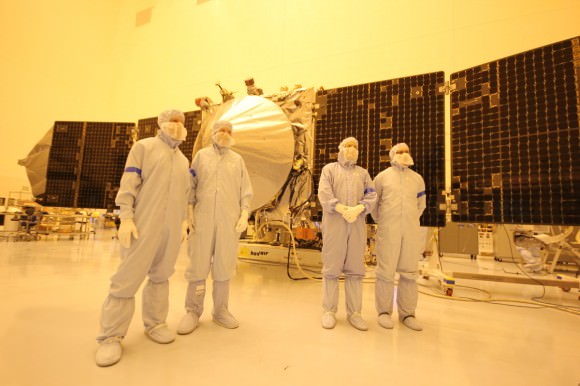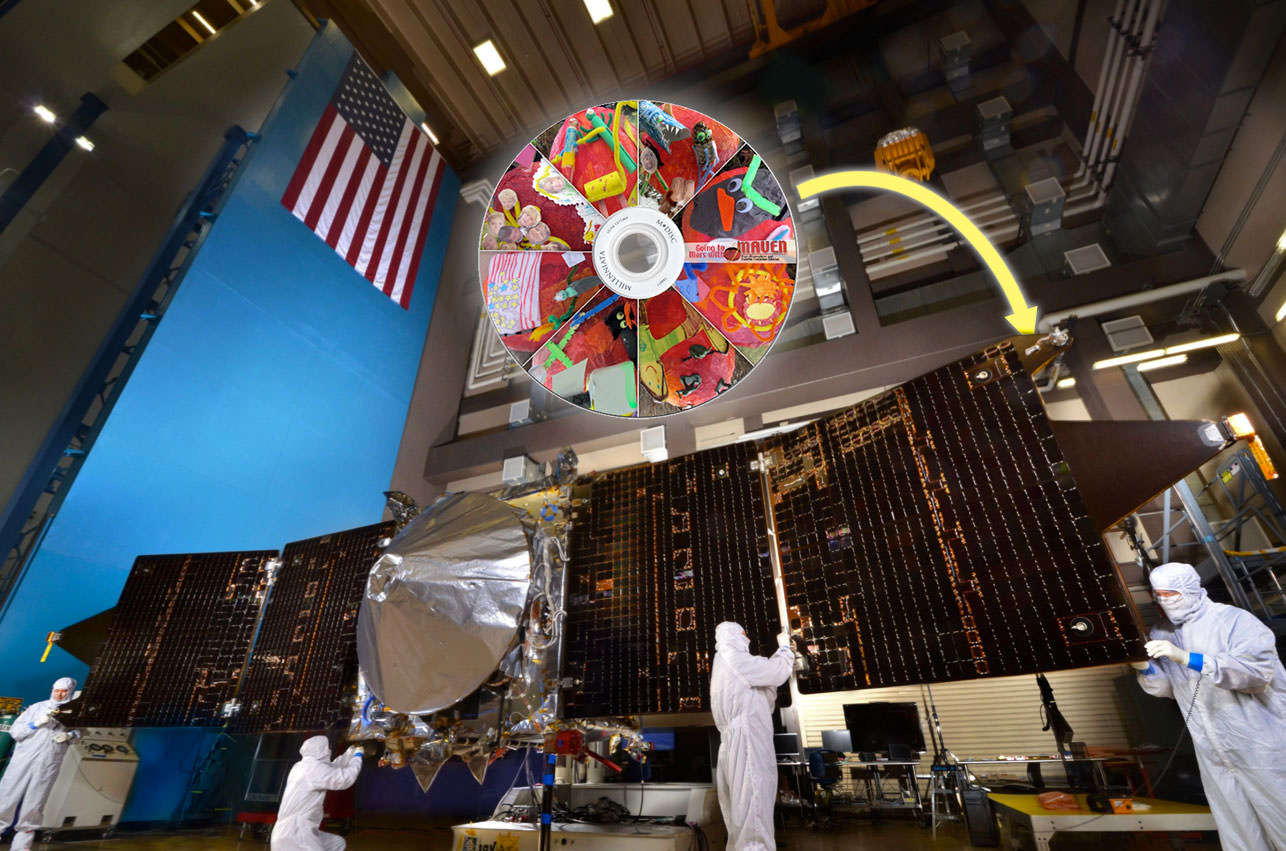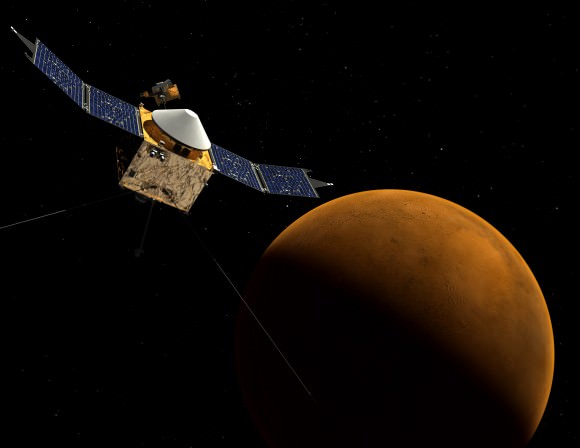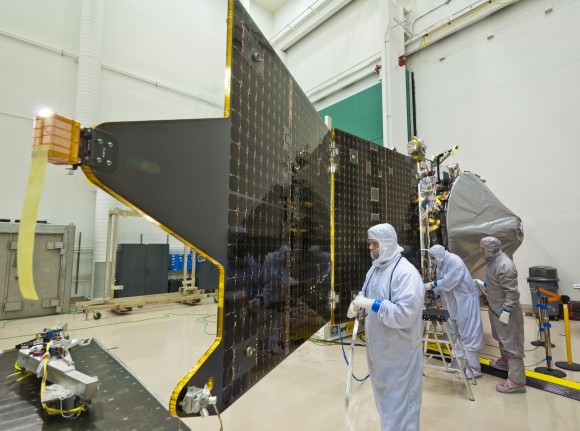Technicians resumed spacecraft preparations for NASA’s MAVEN orbiter today (Oct. 3) aimed towards meeting the hoped for Nov. 18 launch to Mars after receiving an ‘emergency exemption’ from forced furloughs. The Oct. 1 US Government shutdown had stopped all work on MAVEN and various other NASA missions. Credit: Ken Kremer/kenkremer.com
Story updated[/caption]
Following a three day period of complete work stoppage due to the US Government Shutdown, technicians late today (Oct. 3) resumed critical launch preparations for NASA’s next mission to Mars, the MAVEN orbiter. And it’s not a moment too soon, because the consequences of a continued suspension would have been absolutely dire for the entire future of Mars exploration!
“We have already restarted spacecraft processing at the Kennedy Space Center (KSC) today,” Prof. Bruce Jakosky, MAVEN’s chief scientist told Universe Today in a special new mission update today.
Today, Oct 3, top NASA managers have “determined that MAVEN meets the requirements allowing an emergency exception relative to the Anti-Deficiency Act,” Jakosky told me.
MAVEN had been scheduled to blast off for the Red Planet on Nov.18 atop an Atlas V rocket from the Florida Space Coast until those plans were derailed by the start of the government shutdown that began at midnight, Tuesday (Oct. 1) due to senseless and endless political gridlock in Washington, DC.
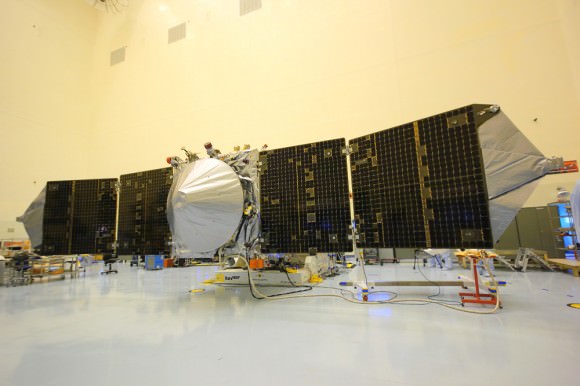
About 97% of NASA’s workforce had been immediately furloughed on Oct. 1 and ordered not to go to work – along with some 800,000 other Federal employees – when their work was deemed “non-essential” despite maintaining spacecraft valued at tens of billions of dollars.
This left only skeleton crews manning Mission Control’s for dozens and dozens of ongoing space missions and the International Space Station (ISS)
Despite the work hiatus, the team is still hoping to achieve an on time launch or soon thereafter.
“We are working toward being ready to launch on Nov. 18,” Jakosky told me, as MAVEN’s principal Investigator of the University of Colorado at Boulder.
“We will continue to work over the next couple of days to identify any changes in our schedule or plans that are necessary to stay on track.”
How realistic is the original Nov. 18 launch date, I asked?
“We think it’s very feasible,” Jakosky responded.
“With our having been shut down for only a few days, we should be back on track toward this date quickly.”
The processing team at KSC lost three days of the nine days of margin in the schedule.
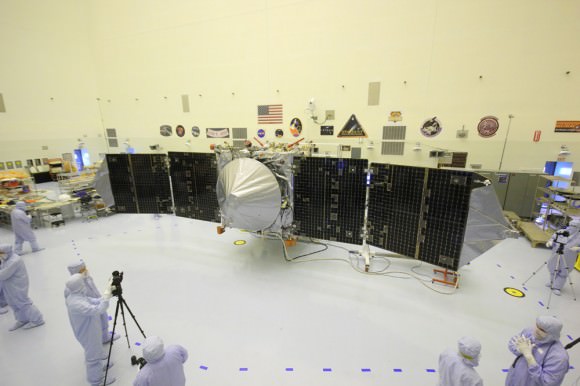
Where does the team pick up with work?
“With the facility now back up and running, we more or less pick up right where we left off,” Jakosky explained
“We are reworking the schedule to make sure our activities are integrated together and that people don’t have to be in two places at once.”
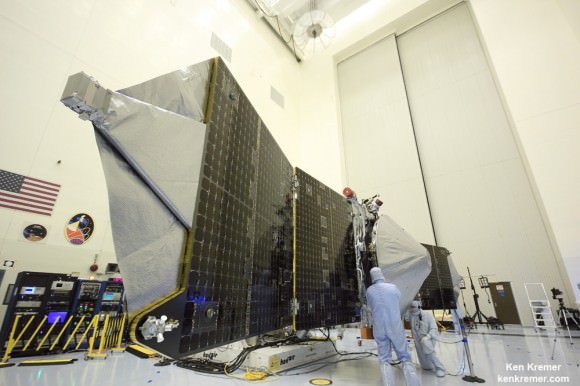
The nominal launch window for NASA’s $650 Million MAVEN (Mars Atmosphere and Volatile EvolutioN Mission) mission to study the Red Planet’s atmosphere only extends about three weeks until Dec. 7.
And he said the team will do whatever necessary, including overtime, to launch MAVEN to the Red Planet by Dec. 7.
“The team is committed to getting to the launch pad at this opportunity, and is willing to work double shifts and seven days a week if necessary. That plus the existing margin gives us some flexibility. “
Interestingly, the ‘’emergency exemption” was granted because of MAVEN’s additional secondary role as a communications relay for NASA’s intrepid pair of surface rovers – Curiosity and Opportunity – and not because of its primary science mission.
“MAVEN is required as a communications relay in order to be assured of continued communications with the Curiosity and Opportunity rovers,” Jakosky explained.
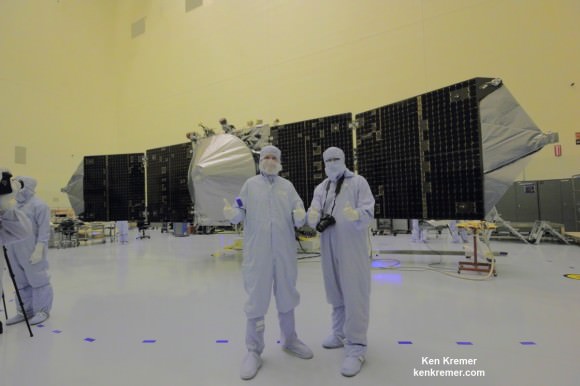
Although NASA has two functioning orbiters circling the Red Planet at this moment, they are getting old, are far beyond their original design lifetimes and suffer occasional glitches. And there is no guarantee of continued operation.
“The rovers are presently supported by Mars Odyssey launched in 2001 and Mars Reconnaissance Orbiter launched in 2005.”
“Launching MAVEN in 2013 protects the existing assets that are at Mars today,” Jakosky told me.
If Mars Odyssey and/or Mars Reconnaissance Orbiter were to fail, then the rovers mission operations would be severely curtailed and could even be terminated prematurely – in a worst case scenario.
And without MAVEN, there would be no point in launching NASA’s planned 2020 rover since there would be no way to transmit the science data back to Earth.
“There is no NASA relay orbiter at Mars planned post-MAVEN,” Jakosky noted.
If MAVEN has to launch later in December 2013 or is forced to be postponed to the next launch window opportunity in 2016, both the communications relay capability and the missions atmospheric science objectives would have been very badly impacted.
“A delay in the launch date by more than a week past the end of the nominal launch period, or a delay of launch to 2016, would require additional fuel to get into orbit.”
“This would have precluded having sufficient fuel for MAVEN to carry out its science mission and to operate as a relay for any significant time,” Jakosky elaborated.
“Our nominal launch period runs from 18 November through 7 December, and we can launch as late as about 15 December without a significant impact on our combined science and relay activities.”
From a purely science standpoint, 2013 is the best time to launch MAVEN to accomplish its science objectives.
“Although the exception for MAVEN is not being done for science reasons, the science of MAVEN clearly will benefit from this action.”
“Launching in 2013 allows us to observe at a good time in the eleven-year solar cycle.”
“MAVENS’s goal is determining the composition of the ancient Martian atmosphere and when it was lost, where did all the water go and how and when was it lost,” said Jakosky.
Stay tuned here for continuing MAVEN and government shutdown updates.
And watch for my articles about critical operations related to LADEE on Oct 6 and JUNO on Oct. 9. The government shutdown negatively impacts these missions and others as well.
…………….
Learn more about MAVEN, Curiosity, Mars rovers, Cygnus, Antares, SpaceX, Orion, LADEE, the Gov’t shutdown and more at Ken’s upcoming presentations
Oct 8: “NASA’s Historic LADEE Lunar & Antares/Cygnus ISS Rocket Launches from Virginia”& “Curiosity and MAVEN updates”; Princeton University, Amateur Astronomers Assoc of Princeton (AAAP), Princeton, NJ, 8 PM

